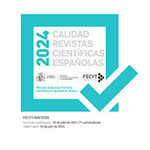Las Decoraciones pictóricas en la cripta de la basílica de San Filóxeno de Oxirrinco (Egipto)
Abstract
At the site of Oxyrhynchus, a city known for its importance in the Byzantine period (4th-7th century CE), the Basilica of St. Philoxenus was found during the 2009 excavation campaign. The excavation and conservation work carried out simultaneously in this crypt made it possible to secure the stucco work, whose richness and variety of decoration was already evident from the outset. Numerous stucco works with very important pictorial decorations were discovered along the entire length and width of the walls. These paintings were examined on the basis of an exhaustive analysis of the stratigraphic arrangement and iconographic analysis of the individual layers. In some places, we were able to identify up to five superimposed plasters with very different decorations. Through the iconographic analysis and its arrangement, we can understand the development of the space within the basilica complex and approach the development of Christianity in Oxyrhynchus in particular and in Egypt in general during these centuries.
Downloads
Article download
License
In order to support the global exchange of knowledge, the journal Eikon Imago is allowing unrestricted access to its content as from its publication in this electronic edition, and as such it is an open-access journal. The originals published in this journal are the property of the Complutense University of Madrid and any reproduction thereof in full or in part must cite the source. All content is distributed under a Creative Commons Attribution 4.0 use and distribution licence (CC BY 4.0). This circumstance must be expressly stated in these terms where necessary. You can view the summary and the complete legal text of the licence.











